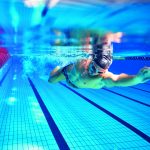Transform your strength, learn how to swim fast!
Speed does not only come “from the ratio between the distance covered and time taken to cover it”, but also from the way in which it is covered. The type of activity (“aerobic” or “speed”) is classed according to the rate at which fuel is consumed or the ATP*. But that is not all, for a swimmer to swim fast and efficiently, strength also has a role to play.
In a previous article, we talked about the importance of explosive power. Today, in relation to speed, we will focus on strength endurance.
Strength endurance is the ability to maintain sub-maximal efforts for a certain number of cycles or the longest amount of time possible, striving to maintain a high speed of execution.
This kind of strength comes from various different components:
- Maximum strength level
- Speed of execution
- Quantity and quality of previous training sessions
- Basic endurance
Here is a circuit to be performed in a gym to help you start developing good endurance strength.
These exercises should be performed one after the other without stopping; you can take a 2 minute rest after completing the fourth exercise.
1. Press ups
2. Pull ups (assisted if necessary)
3. Jumps over obstacles with your legs together
4. Jumps using your arms for thrust
Each exercise is performed for 15-20 seconds for a total of three sets. Then try increasing the length of each exercise to 45-60 seconds.
Having completed this circuit, you can attempt to “transform” this work in the pool or, in other words, actually apply the strength you have gained in the gym while swimming in the pool.
The following are three workouts of different levels. The first is the easiest and the last is the hardest, choose the right one for your ability.
Easy level: 8×25 freestyle, swimming 12.5 m slow and 12.5 m fast, 30”recovery. At the end of these sets, swim 4×25 m flat out with 60 recovery.”
Intermediate level: 12×25 freestyle with fins at full speed, 30” recovery. 200 m recovery swim. 3×50 m freestyle with dive (if possible) 1’30” recovery.
Advanced level: 2 sets of 1×25 m with 60” rest, 1×50 m with 2’ rest, 1×75 with 2’30 rest, all performed flat out swimming 200 m between sets.
Swimming fast is an art. Learn to understand and manage your body both in and out of the water, because the fastest swimmer is not the strongest or the most talented but the most balanced.
* ATP is the high-energy compound required by most metabolic reactions.
—————
Written by:
arena coaches
Swim coaches, trainers and experts will give you all kinds of tips for performing at your best in both training and races.







